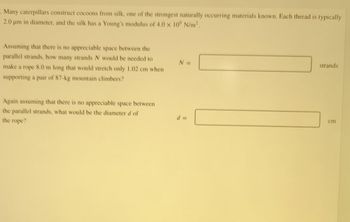Question
Please no hand writing solution

Transcribed Image Text:Many caterpillars construct cocoons from silk, one of the strongest naturally occurring materials known. Each thread is typically
2.0 µm in diameter, and the silk has a Young's modulus of 4.0 × 10° N/m².
Assuming that there is no appreciable space between the
parallel strands, how many strands N would be needed to
make a rope 8.0 m long that would stretch only 1.02 cm when
supporting a pair of 87-kg mountain climbers?
Again assuming that there is no appreciable space between
the parallel strands, what would be the diameter d of
the rope?
N =
d =
strands
cm
Expert Solution
This question has been solved!
Explore an expertly crafted, step-by-step solution for a thorough understanding of key concepts.
This is a popular solution
Trending nowThis is a popular solution!
Step by stepSolved in 3 steps

Knowledge Booster
Similar questions
arrow_back_ios
arrow_forward_ios